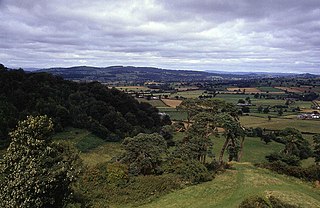The Battle of Nantwich was fought on 25 January 1644 in Cheshire during the First English Civil War. In the battle, Sir Thomas Fairfax in command of a Parliamentarian relief force defeated Lord Byron and the Royalists.

Sir William Brereton, 1st Baronet, (1604–1661), was an English Puritan who owned extensive estates in Cheshire, and was Member of Parliament for Cheshire at various times between 1628 and 1653. During the First English Civil War, he was commander of Parliamentarian forces in the North Midlands.

Middlewich is a town in the unitary authority of Cheshire East and the ceremonial county of Cheshire, England. It is 19.2 miles (30.9 km) east of the city of Chester, 2.9 miles (4.7 km) east of Winsford, 5.3 miles (8.5 km) southeast of Northwich and 4.7 miles (7.6 km) northwest of Sandbach. The population of the town at the 2011 Census was 13,595.

The Battle of Hopton Heath was a battle of the First English Civil War, fought on Sunday 19 March 1643 between Parliamentarian forces led by Sir John Gell, 1st Baronet and Sir William Brereton and a Royalist force under Spencer Compton, 2nd Earl of Northampton.
The First Battle of Middlewich took place on 13 March 1643, during the First English Civil War, and was fought between the Parliamentarians, under Sir William Brereton, and the Royalist supporters of King Charles I of England, under Sir Thomas Aston.
Middlewich is one of the Wich towns in Cheshire, England.
The Bunbury Agreement of December 23, 1642 was a declaration of neutrality drawn up by some prominent gentlemen of the county of Cheshire shortly after the outbreak of the First English Civil War. Like similar attempts in Lancashire and other counties, it was ignored by both Parliament and Charles I, since the strategic importance of Cheshire and the city port of Chester meant national interests overruled local ones.

Bradwall is a small village and civil parish in the unitary authority of Cheshire East, about 2 mi (3.2 km) northwest of Sandbach in the ceremonial county of Cheshire, England, and about 20 mi (32 km) south of Manchester. According to the 2011 census, the population of the entire parish was 182. The area is predominantly agricultural, with no manufacturing or retail outlets.

Brindley is a village and civil parish in Cheshire, England. The village lies 3¾ miles to the west of Nantwich. The parish also includes the settlements of Brindley Lea, Ryders Bank and part of Radmore Green, with a total population of about 150. Nearby villages include Barbridge, Burland, Haughton and Faddiley.

Stoke is a civil parish in the unitary authority of Cheshire East and the ceremonial county of Cheshire, England. The parish is predominantly rural with a total population of around 200, measured with the inclusion of Hurleston at 324 in the 2011 Census. The largest settlement is Barbridge, which lies 3½ miles to the north west of Nantwich. The parish also includes the small settlements of Stoke Bank and Verona. Nearby villages include Aston juxta Mondrum, Burland, Calveley, Haughton, Rease Heath and Wardle.
The Grade I listed buildings in Cheshire, excluding those in the city of Chester, total around 80. Almost half of these are churches that are contained in a separate list.

Middlewich railway station served the Cheshire, England, salt-producing town of Middlewich between 1868 and 1960. It lay on a branch line from Sandbach to Northwich. The Mid Cheshire Rail Users' Association is campaigning for the reopening of the line to passenger traffic, and the construction of a new station at Middlewich.

Robert Venables, was an English soldier from Cheshire, who fought for Parliament in the 1638 to 1651 Wars of the Three Kingdoms, and captured Jamaica in 1655.
The timeline of Cheshire history shows significant events in the history of the English county of Cheshire.

The siege of Chester occurred over a 16-month period between September 1644 and February 1646 during the First English Civil War. In the engagement, Sir William Brereton and the Parliamentarians were ultimately successful in taking possession of the city and Royalist garrison commanded by Lord Byron.

The Battle of Montgomery took place during the First English Civil War of 1642–1646. On 17 September 1644, a Parliamentarian force commanded by Sir John Meldrum advanced to engage a Royalist army led by Lord Byron which was besieging Montgomery Castle in mid Wales. The battle was fought the next day. After the Royalists gained an initial advantage, the Parliamentarians counter-attacked and destroyed Byron's army.

The Capture of Wakefield occurred during the First English Civil War when a Parliamentarian force attacked the Royalist garrison of Wakefield, Yorkshire. The Parliamentarians were outnumbered, having around 1,500 men under the command of Sir Thomas Fairfax, compared to the 3,000 led by George Goring in Wakefield, but successfully stormed the town, taking roughly 1,400 prisoners.
During the first English Civil War, Tarvin, a village in Cheshire, England, was garrisoned by both sides and was attacked by both sides, because its proximity to Chester, which was a major Royalist (Cavalier) port city, made it strategically important. Tarvin changed hands several times; initially it was garrisoned by Parliament and troops of both sides at different times were quartered in and around the village, which was not fortified. In September 1644 the Parliamentarians (Roundheads) fortified the village and garrisoned the place with sufficient troops to withstand a large attack and it remained in their hands until the end of the war.












